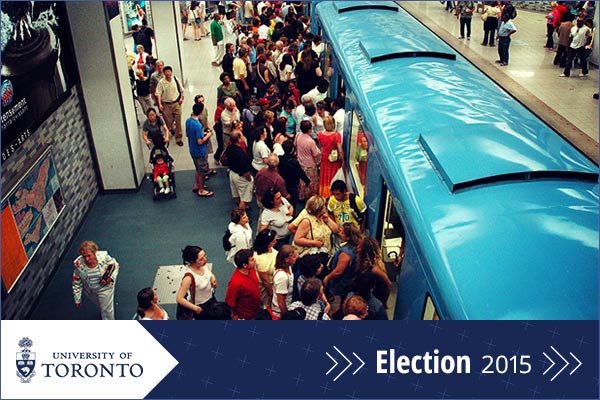
Election 2015: will the new government pay enough attention to city issues?
Published: October 15, 2015
In what Edmonton Mayor Don Iveson described as a “bidding war for cities” during the federal election campaign, all three main parties announced multi-billion dollar spending plans for transit, infrastructure and public housing.
But Professor Matti Siemiatycki says implementing a national standardized assessment process for infrastructure spending would be just as important as money.
In the weeks leading up to the election, U of T News asked experts from across the university for their analysis of the major issues, the debates, political advertising, public opinion polling and more.
Read more Election 2015 coverage
Siemiatycki is an associate professor of geography focusing on infrastructure planning, transportation, cycling and public-private partnerships. He has conducted transportation studies in London, Los Angeles, Sydney and Delhi as well as Toronto. And, in September, he was one of the organizers of the launch of an unprecedented survey of university students on their public transit needs.
While municipalities are creatures of the provinces and the federal government is more hands-off, Siemiatycki believes Ottawa can play a major role in both funding and creating national programs “to benefit key urban agendas on transportation, public housing and child care.”
“These are areas that deeply affect cities, and where sustained funding is necessary to make these programs a reality, and really improve the quality of our cities,” Siemiatycki said. “The federal government can play a unifying role at the national level.”
Committing large amounts of money is important but “what is most important about the funding package is the duration and stability of it,” he said. Major infrastructure programs are ongoing initiatives that roll out over many years but, in the past, funding for municipalities has come in “short bursts or unpredictable bursts, with decisions being made ad hoc” for political reasons.
The federal government can make a real contribution in the area of public transit by creating “common frameworks on how we evaluate transportation priorities,” he said. In Canada, many transportation decisions are now made on an ad hoc basis. Some are well planned but with others “you get the sense that politics was the key driver of those decisions.”
Other countries, including Britain, have developed evaluation frameworks or assessment models that projects which receive federal funding must follow. It doesn’t mean that the federal government would choose the projects; that would still be left up to local politicians, who are closer to the public’s needs.
The federal government can play a “role synchronizing how we assess the decisions so that the process of deciding becomes more rigorous and produces standardized methodologies across the country.”
While the need for new transportation initiatives is great, “the risk of investing large amounts of money in projects that aren’t going to deliver the stated goals or make our transportation system better is really problematic,” Semiatycki said.
He pointed to the Sheppard subway line in Toronto which cost about $1 billion to construct, but has become a “lost opportunity” because of low ridership and the huge on-going operational and maintenance costs.
“What’s worse is that with the project being subsidized for a decade with ridership so low, it siphons funds away from other projects that could benefit us all more.”
One short term move the federal government could make, he said, would be to provide sales tax relief for people who buy bicycles or increase the tax write-off for those who buy monthly transit passes.
Siemiatycki said there is an “urgent need for affordable housing across the country,” with the costs being downloaded over the last several years to municipalities, which cannot afford it. The federal government takes in the vast majority of tax revenue in the country, he said, and can afford to act.
There is a “multi-billion-dollar backlog just in terms of maintenance of public housing,” he said without even getting to building new units for the thousands of people on the waiting list.
“Long-term and sustained federal funding would have incredible public benefits.”
Affordable daycare, he said, is important. “Providing options for people is extremely critical.” Not having them is a great “inhibitor to people accessing the job market, especially women.”
The transit survey launched at Toronto City Hall in September is a product of a collaboration of the four universities in Toronto – U of T, York, Ryerson and OCAD. It will also be examining the issue of public housing.
Read more about the transit survey
Surveys began being e-mailed to students on Sept. 28. Siemiatycki said more than 1,500 questionnaires have been returned but none of the data has been analyzed yet.
(Below: President Gertler and the presidents of Ryerson, OCAD-U and York universities join policy leaders and students at Toronto City Hall for a discussion of the obstacles students confront when travelling in the region/photo by Johnny Guatto)




